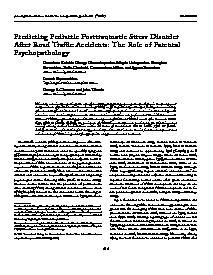Predicting Pediatric Posttraumatic Stress Disorder After Road Traffic Accidents : The Role of Parental Psychopathology
This study examined prospectively the role of parental psychopathology among other predictors in the development and persistence of posttraumatic stress disorder (PTSD) in 57 hospitalized youths aged 7–18 years immediately after a road traffic accident and 1 and 6 months later. Self report questionnaires and semistructured diagnostic interviews were used in all 3 assessments. Neuroendocrine evaluation was performed at the initial assessment. Maternal PTSD symptomatology predicted the development of children’s PTSD 1 month after the event, OR = 6.99, 95% CI [1.049, 45.725]; the persistence of PTSD 6 months later was predicted by the child’s increased evening salivary cortisol concentrations within 24 hours of the accident, OR = 1.006, 95% CI [1.001, 1.011]. Evaluation of both biological and psychosocial predictors that increase the risk for later development and maintenance of PTSD is important for appropriate early prevention and treatment.
Geachte bezoeker,
De informatie die u nu opvraagt, kan door psychotraumanet niet aan u worden getoond. Dit kan verschillende redenen hebben,
waarvan (bescherming van het) auteursrecht de meeste voorkomende is. Wanneer het mogelijk is om u door te verwijzen naar de bron
van deze informatie, dan ziet u hier onder een link naar die plek.
Als er geen link staat, kunt u contact opnemen met de bibliotheek,
die u verder op weg kan helpen.
Met vriendelijke groet,
Het psychotraumanet-team.
In: Journal of Traumatic Stress ISSN: 1573-6598 | 24 | 4 | 414-421
https://doi.org/10.1002/jts.20667


